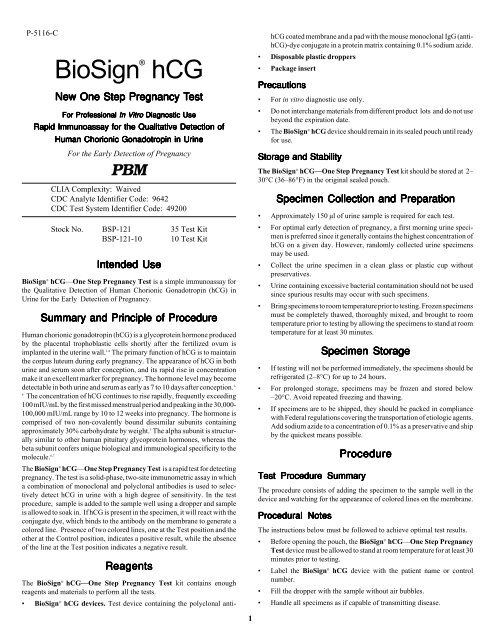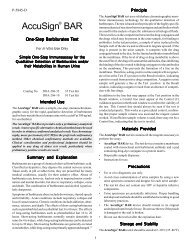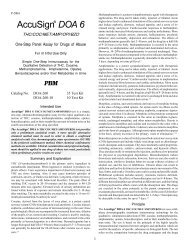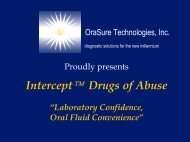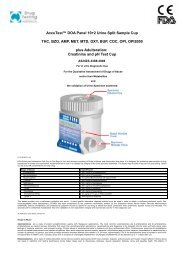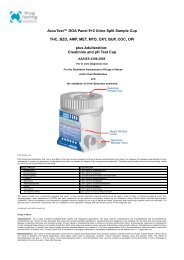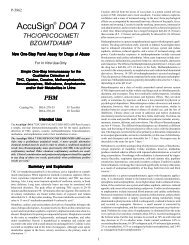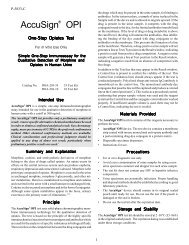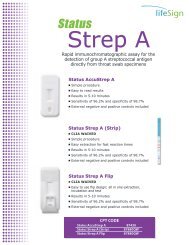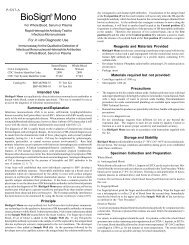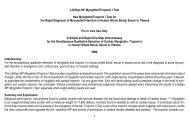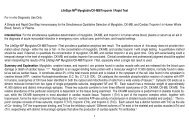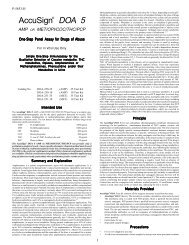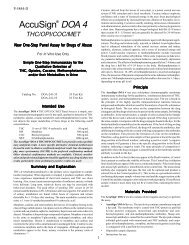BioSign® hCG - Drug Testing
BioSign® hCG - Drug Testing
BioSign® hCG - Drug Testing
You also want an ePaper? Increase the reach of your titles
YUMPU automatically turns print PDFs into web optimized ePapers that Google loves.
P-5116-C<br />
BioSign ®<br />
<strong>hCG</strong><br />
New One Step Pregnancy Test<br />
For Professional In Vitro Diagnostic Use<br />
Rapid Immunoassay for the Qualitative Detection of<br />
Human Chorionic Gonadotropin in Urine<br />
For the Early Detection of Pregnancy<br />
PBM<br />
CLIA Complexity: Waived<br />
CDC Analyte Identifier Code: 9642<br />
CDC Test System Identifier Code: 49200<br />
Stock No. BSP-121 35 Test Kit<br />
BSP-121-10 10 Test Kit<br />
Intended Use<br />
BioSign ® <strong>hCG</strong>—One Step Pregnancy Test is a simple immunoassay for<br />
the Qualitative Detection of Human Chorionic Gonadotropin (<strong>hCG</strong>) in<br />
Urine for the Early Detection of Pregnancy.<br />
Summary and Principle of Procedure<br />
Human chorionic gonadotropin (<strong>hCG</strong>) is a glycoprotein hormone produced<br />
by the placental trophoblastic cells shortly after the fertilized ovum is<br />
implanted in the uterine wall. 1-4 The primary function of <strong>hCG</strong> is to maintain<br />
the corpus luteum during early pregnancy. The appearance of <strong>hCG</strong> in both<br />
urine and serum soon after conception, and its rapid rise in concentration<br />
make it an excellent marker for pregnancy. The hormone level may become<br />
detectable in both urine and serum as early as 7 to 10 days after conception. 1-<br />
4<br />
The concentration of <strong>hCG</strong> continues to rise rapidly, frequently exceeding<br />
100 mIU/mL by the first missed menstrual period and peaking in the 30,000-<br />
100,000 mIU/mL range by 10 to 12 weeks into pregnancy. The hormone is<br />
comprised of two non-covalently bound dissimilar subunits containing<br />
approximately 30% carbohydrate by weight. 5 The alpha subunit is structurally<br />
similar to other human pituitary glycoprotein hormones, whereas the<br />
beta subunit confers unique biological and immunological specificity to the<br />
molecule. 6,7<br />
The BioSign ® <strong>hCG</strong>—One Step Pregnancy Test is a rapid test for detecting<br />
pregnancy. The test is a solid-phase, two-site immunometric assay in which<br />
a combination of monoclonal and polyclonal antibodies is used to selectively<br />
detect <strong>hCG</strong> in urine with a high degree of sensitivity. In the test<br />
procedure, sample is added to the sample well using a dropper and sample<br />
is allowed to soak in. If <strong>hCG</strong> is present in the specimen, it will react with the<br />
conjugate dye, which binds to the antibody on the membrane to generate a<br />
colored line. Presence of two colored lines, one at the Test position and the<br />
other at the Control position, indicates a positive result, while the absence<br />
of the line at the Test position indicates a negative result.<br />
Reagents<br />
The BioSign ® <strong>hCG</strong>—One Step Pregnancy Test kit contains enough<br />
reagents and materials to perform all the tests.<br />
• BioSign ® <strong>hCG</strong> devices. Test device containing the polyclonal anti-<br />
1<br />
<strong>hCG</strong> coated membrane and a pad with the mouse monoclonal IgG (anti<strong>hCG</strong>)-dye<br />
conjugate in a protein matrix containing 0.1% sodium azide.<br />
• Disposable plastic droppers<br />
• Package insert<br />
Precautions<br />
• For in vitro diagnostic use only.<br />
• Do not interchange materials from different product lots and do not use<br />
beyond the expiration date.<br />
• The BioSign ® <strong>hCG</strong> device should remain in its sealed pouch until ready<br />
for use.<br />
Storage and Stability<br />
The BioSign ® <strong>hCG</strong>—One Step Pregnancy Test kit should be stored at 2–<br />
30°C (36–86°F) in the original sealed pouch.<br />
Specimen Collection and Preparation<br />
• Approximately 150 µl of urine sample is required for each test.<br />
• For optimal early detection of pregnancy, a first morning urine specimen<br />
is preferred since it generally contains the highest concentration of<br />
<strong>hCG</strong> on a given day. However, randomly collected urine specimens<br />
may be used.<br />
• Collect the urine specimen in a clean glass or plastic cup without<br />
preservatives.<br />
• Urine containing excessive bacterial contamination should not be used<br />
since spurious results may occur with such specimens.<br />
• Bring specimens to room temperature prior to testing. Frozen specimens<br />
must be completely thawed, thoroughly mixed, and brought to room<br />
temperature prior to testing by allowing the specimens to stand at room<br />
temperature for at least 30 minutes.<br />
Specimen Storage<br />
• If testing will not be performed immediately, the specimens should be<br />
refrigerated (2–8°C) for up to 24 hours.<br />
• For prolonged storage, specimens may be frozen and stored below<br />
–20°C. Avoid repeated freezing and thawing.<br />
• If specimens are to be shipped, they should be packed in compliance<br />
with Federal regulations covering the transportation of etiologic agents.<br />
Add sodium azide to a concentration of 0.1% as a preservative and ship<br />
by the quickest means possible.<br />
Procedure<br />
Test Procedure Summary<br />
The procedure consists of adding the specimen to the sample well in the<br />
device and watching for the appearance of colored lines on the membrane.<br />
Procedural Notes<br />
The instructions below must be followed to achieve optimal test results.<br />
• Before opening the pouch, the BioSign ® <strong>hCG</strong>—One Step Pregnancy<br />
Test device must be allowed to stand at room temperature for at least 30<br />
minutes prior to testing.<br />
• Label the BioSign ® <strong>hCG</strong> device with the patient name or control<br />
number.<br />
• Fill the dropper with the sample without air bubbles.<br />
• Handle all specimens as if capable of transmitting disease.
Add 3 drops<br />
(150 µL)<br />
Read in<br />
3–10<br />
minutes<br />
<strong>hCG</strong><br />
C<br />
T<br />
<strong>hCG</strong><br />
C<br />
T<br />
OR<br />
C<br />
T<br />
OR<br />
C<br />
T<br />
C<br />
T<br />
S<br />
S<br />
S<br />
T<br />
C<br />
<strong>hCG</strong><br />
1 Line at C position<br />
= Negative (–)<br />
2 Lines = Positive (+)<br />
• After testing, dispose of the BioSign ® <strong>hCG</strong> device, and the dropper<br />
following good laboratory practices. Consider each material that comes<br />
in contact with specimen to be potentially infectious.<br />
Materials Provided<br />
• BioSign ® <strong>hCG</strong> devices<br />
• Disposable droppers<br />
Materials Required But Not Provided<br />
• Timer<br />
• Specimen cup<br />
Test Protocol<br />
1. For each test, open one BioSign ® <strong>hCG</strong> pouch.<br />
2. Holding the dropper in a vertical position, add 3 drops<br />
(150 µl) of sample into the sample well (S).<br />
3. Read the result after 3 minutes, but within 10 minutes.<br />
How to Read the Test<br />
Results<br />
Positive: Two pinkish-purple lines, one each at the Test position (T) and<br />
at the Control position (C). One of the following indicates a positive test<br />
result:<br />
a. Two strong pinkish-purple lines, one each at the Test (T) and Control<br />
(C) positions.<br />
b. One strong pinkish-purple line at the Test position (T) and one light<br />
pinkish-purple line at the Control position (C).<br />
c. One light pinkish-purple line in the Test position (T) and one strong<br />
pinkish-purple colored line at the Control position (C).<br />
Negative: Only one pinkish-purple line at the Control position (C).<br />
Notes on Results<br />
Positive<br />
A specimen containing a detectable level of <strong>hCG</strong> will generate pinkishpurple<br />
lines at the Control position (C) and at the Test position (T) within<br />
3 minutes. The time required to generate the line is dependent on the <strong>hCG</strong><br />
concentration in the sample. Positive results may be detected in as early as<br />
one (1) minute, depending on the <strong>hCG</strong> concentration. To be interpreted as<br />
positive, the pinkish-purple line at the Test position should be clearly<br />
distinguishable from the background color of the membrane. In strong<br />
positive tests, the color intensity of the Control line (C) may be much lighter<br />
than that of the Test line (T). Note: The high dose hook effect has been found<br />
to occur at approximately 500,000 mIU/mL. For samples with extremely<br />
high concentration of <strong>hCG</strong>, the higher the <strong>hCG</strong> concentration, the lighter the<br />
color band at the test region may become.<br />
Negative<br />
In the absence of <strong>hCG</strong>, or in the case that the <strong>hCG</strong> concentration is below the<br />
detection limit of the test, there will be no apparent line at the Test position;<br />
rather, there may be a uniform background color over the membrane area.<br />
The Control line at the Control position should be clearly visible.<br />
Inconclusive or Invalid Results<br />
If there is no distinct pinkish-purple line visible at the Control position, the<br />
test is inconclusive. The Control line should always appear. If there is a<br />
suspected procedural error, the result should be considered inconclusive. It<br />
is recommended that in these cases the test be repeated with a new test<br />
device.<br />
Limitations<br />
• An extremely low concentration of <strong>hCG</strong> during the early stage of<br />
pregnancy can give a negative result. In this case, testing of another<br />
specimen obtained at least 48 hours later is recommended.<br />
• The <strong>hCG</strong> level may remain detectable for several weeks after normal<br />
delivery, delivery by caesarean section, spontaneous miscarriage, or<br />
therapeutic abortion. 11<br />
• The test is highly sensitive, and specimens which test positive during the<br />
initial days after conception may later be negative due to natural<br />
termination of the pregnancy. Natural termination occurs in 22% of<br />
clinically unrecognized pregnancies and 31% of pregnancies overall. 12<br />
Subsequent testing of a new urine sample after an additional 48 hours<br />
is recommended in order to confirm that the <strong>hCG</strong> level is rising as<br />
indicated in a normal pregnancy.<br />
• The concentration of <strong>hCG</strong> may be very low in the case of ectopic<br />
pregnancy. 13 A suspected ectopic pregnancy may be further evaluated<br />
by a physician.<br />
• In addition to pregnancy, elevated <strong>hCG</strong> levels have been reported in<br />
2
patients with both gestational and nongestational trophoblastic diseases.<br />
8,9,10 The <strong>hCG</strong> of trophoblastic neoplasms is similar to that found<br />
in pregnancy, so these conditions, including choriocarcinoma and<br />
hydatidiform mole, should be ruled out before pregnancy is diagnosed.<br />
• Very high levels of <strong>hCG</strong> may exist in certain pregnancies and pathological<br />
conditions (e.g., choriocarcinoma and hydatidiform mole). This<br />
may weaken the test line.<br />
• As is true with any diagnostic procedure, the physician should evaluate<br />
data obtained by using this kit in light of other clinical information.<br />
• Samples which contain excessive bacterial contamination or have been<br />
subjected to repeated freezing and thawing should not be used because<br />
such specimens can give spurious results.<br />
• Urine samples with low specific gravity may not contain representative<br />
levels of <strong>hCG</strong>. If such a sample is negative or weakly positive, a first<br />
morning specimen should be used for retesting.<br />
User Quality Control<br />
• Control standards are not provided with this kit; however, it is recommended<br />
that controls be tested at regular intervals as good testing<br />
practice and whenever there is any doubt about the interpretation of the<br />
test result. It is recommended that a positive control which is near the<br />
sensitivity limit of the assay be used for assay control. For information<br />
on how to obtain controls, contact PBM for technical assistance. Before<br />
using a new lot of kit, a quality control test using the positive and<br />
negative control should be conducted to confirm the expected Q.C.<br />
results and the validity of the assay. Upon confirmation of the expected<br />
results, the kit is ready for use with patient specimens.<br />
• The control line at the Control position can be considered an internal<br />
procedural control, i.e., a proper amount of sample is used; sample is<br />
added to the sample well, and not through the Result Window; and the<br />
reagent system worked properly. A distinct pinkish-purple control line<br />
will always appear if the test has been performed correctly. If the control<br />
line does not appear, the test is invalid and a new test should be<br />
performed. If the problem persists, contact PBM for technical assistance.<br />
• A clear background in the Result Window is considered an internal<br />
negative procedural control. If the test is performed correctly and the<br />
BioSign ® <strong>hCG</strong> device is working properly, the background in the Result<br />
Window should be clear, providing a distinct negative result.<br />
Expected Values<br />
BioSign ® <strong>hCG</strong>—One Step Pregnancy Test is capable of detecting <strong>hCG</strong><br />
level of 15 mIU/mL (WHO 3rd International Standard, previously known as<br />
the 1st I.R.P). The levels of <strong>hCG</strong> in normal early pregnant women vary.<br />
However, <strong>hCG</strong> levels often exceed 100 mIU/mL by the first day of the<br />
missed menstrual period. 1 The test is usually capable of confirming pregnancy<br />
by the first day of the missed menstrual period.<br />
Clinical Evaluation<br />
Performance Characteristics<br />
A total of 247 blind clinical urine samples were studied. These specimens<br />
were assayed with BioSign ® <strong>hCG</strong>—One Step Pregnancy Test and Tandem<br />
® Icon ® II according to the package inserts (Table 1). Thirty-six (36)<br />
samples are from menopausal women.<br />
Table 1<br />
BioSign ® <strong>hCG</strong>—One Step Pregnancy Test vs. Tandem ® Icon ® II<br />
Test Result (# of Samples)<br />
Tandem ® Icon ® II BioSign ® <strong>hCG</strong><br />
Positive (+) 78 78<br />
Negative (–) 133 133<br />
Menopausal Not Determined 36 (Negative, –)<br />
Relative Sensitivy 100%<br />
Relative Specificity 100%<br />
Overall Agreement 100%<br />
The data demonstrate the excellent correlation between BioSign ® <strong>hCG</strong>—<br />
One Step Pregnancy Test and Tandem ® Icon ® II. The clinical accuracy and<br />
sensitivity of the two tests were found to be comparable.<br />
Physicians’ Office Laboratory Evaluation (Proficiency<br />
Study)<br />
Reproducibility of BioSign ® <strong>hCG</strong> test was evaluated at three physicians’<br />
offices using a total of 60 blind control samples. The panels consisted of 5<br />
negative (–), 5 low positive (25 mIU/mL <strong>hCG</strong>), 5 moderate positive (200<br />
mIU/mL <strong>hCG</strong>), and 5 high positive (500 mIU/mL <strong>hCG</strong>) samples. The results<br />
obtained at each site agreed 100% with expected results.<br />
Sensitivity<br />
Standard controls (calibrated to the WHO 3rd International Standard)<br />
ranging from 5 mIU/mL to 50 mIU/mL were tested in 5 replicates. The<br />
results confirmed the sensitivity of 15 mIU/mL in 3 to 4 minutes and 25 mIU/<br />
mL in 2 minutes assay time (Table 2).<br />
Table 2. Sensitivity–Example<br />
BioSign ® <strong>hCG</strong>—One Step Pregnancy Test Sensitivity and Assay Time<br />
Standards (<strong>hCG</strong>, mIU/mL)<br />
<strong>hCG</strong> concentration 5 10 15 20 25 50<br />
Time required for 7' 4' 2’40” 2’20” 1’50” 58”<br />
Positive Signal<br />
Specificity<br />
Thirty-six urine specimens collected from menopausal women were studied.<br />
Specimens from menopausal women are known to interfere frequently with<br />
pregnancy tests due to cross-reactivity with other gonadotropin hormones<br />
such as Leutenizing hormone. These specimens were assayed with BioSign ®<br />
<strong>hCG</strong>—One Step Pregnancy Test. All 36 specimens were found negative.<br />
The assay is free of interference from other commonly known homologous<br />
hormones when tested against the levels specified below.<br />
Homologous Hormones:<br />
hFSH 1000 mIU/mL<br />
hLH 500 mIU/mL<br />
hTSH 1000 µIU/mL<br />
Other Interfering Substances<br />
At the level of claimed sensitivity, BioSign ® <strong>hCG</strong>—One Step Pregnancy<br />
Test showed no interference when the following potentially interfering<br />
substances, both endogenous and exogenous, were added to urine samples<br />
which had <strong>hCG</strong> levels of 0 and 25 mIU/mL (Table 3).<br />
3
Table 3. Potentially Interfering Substances added to Urine and<br />
Tested with the BioSign ® <strong>hCG</strong>—One Step Pregnancy Test<br />
Substance Added<br />
<strong>Drug</strong>s:<br />
Acetaminophen<br />
Acetylsalicylic Acid<br />
Ampicillin<br />
Ascorbic Acid<br />
Atropine<br />
Caffeine<br />
Gentisic Acid<br />
Phenothiazine<br />
Phenylpropanolamine<br />
Salicylic Acid<br />
Tetracycline<br />
Urinary Analytes:<br />
Bilirubin<br />
Glucose<br />
Hemoglobin<br />
Ketones<br />
Albumin<br />
Concentration in Urine<br />
20 mg/dl<br />
20 mg/dl<br />
20 mg/dl<br />
20 mg/dl<br />
20 mg/dl<br />
20 mg/dl<br />
20 mg/dl<br />
20 mg/dl<br />
20 mg/dl<br />
20 mg/dl<br />
20 mg/dl<br />
2 mg/dl<br />
2000 mg/dl<br />
25 mg/dl<br />
100 mg/dl<br />
2000 mg/dl<br />
Bibliography<br />
1. Braunstein, G.D., Rasor, J., Adler, D., Danzer, H., and Wade, M.E.<br />
Serum Human Chorionic Gonadotropin Levels Throughout Normal<br />
Pregnancy. Am. J. Obstet. Gynecol. 1976; 126:678.<br />
2. Krieg, A.F. Pregnancy Tests and Evaluation of Placental Function in:<br />
Clinical Diagnosis and Management by Laboratory Methods, 16th ed.,<br />
Henry, J.B. (ed.) W.B. Saunders Co., Philadelphia, pp. 680, 1979.<br />
3. Brody, S. and Carlstrom, G. Immunoasay of Human Chorionic<br />
Gonadotropin in Normal and Pathologic Pregnancy. J. Clin. Endocrinol.<br />
Metab. 1962; 22:564.<br />
4. Hussa, R.O. Human Chorionic Gonadotropin, A Clinical Marker:<br />
Review of its Biosynthesis. Ligand Review 1981; 3:6.<br />
5. Swaminathan, N. and Bahl, O.P. Dissociation and Recombination of<br />
the Subunits of Human Chorionic Gonadotropin. Biochem. Biophys.<br />
Res. Commun. 1970; 40:422.<br />
6. Ross, G.T. Clinical Relevance of Research on the Structure of Human<br />
Chorionic Gonadotropin. Am. J. Obstet. Gynecol. 1977; 129:795.<br />
7. Reuter, A.M., Gaspard, U.J., Deville, J-L., Vrindts-Gevaert, Y. and<br />
Franchimont, P. Serum Concentrations of Human Chorionic Gonadotrophin<br />
and its Alpha and Beta Subunits. 1. During Normal Singleton<br />
and Twin Pregnancies. Clin. Endocrinol. 1980; 13:305.<br />
8. Morrow, C.P., et al. Clinical and Laboratory Correlates of Molar Pregnancy<br />
and Trophoblastic Disease. Am. J. Obstet Gynecol. 1977; 50:424-430.<br />
9. Dawood, M.Y., Saxena, B.B., and Landesman, R. Human Chorionic<br />
Gonadotropin and its Subunits in Hydatidiform Mole and Choriocarcinoma.<br />
Am. J. Obstet. Gynecol. 1977; 50:172–181.<br />
10. Braunstein, G.D., Vaitukaitis, J.L., Carbone, P.P., and Ross, G. T. Ectopic<br />
Production of Human Chorionic Gonadotropin by Neoplasms. Ann. Inter.<br />
Med. 1973; 78:39-45.<br />
11. Steier, J.A., Bergsjo, P., and Myking, O.L. Human Chorionic Gonadotropin<br />
in Maternal Plasma After Induced Abortion, Spontaneous Abortion,<br />
and Removed Ectopic Pregnancy. Am. J. Obstet. Gynecol. 1984;<br />
64:391-394.<br />
12. Wilcox, A.J., Weinberg, C.R., O’Connor , J.F., Baird, D.D., Schlatterer,<br />
J.P., Canfield, R.E., Armstrong, E.G., and Nisula, B.C. Incidence of early<br />
loss of pregnancy. N. Engl. J. Med. 1988; 319:189-194.<br />
13. Thorneycroft, I.H. When You Suspect Ectopic Pregnancy. Diagnosis,<br />
January: 67-82, 1976.<br />
Symbols Key<br />
Manufactured by<br />
CE Mark<br />
Authorized Representative<br />
In Vitro Diagnostic Medical Device<br />
Catalog Number<br />
Consult Instructions for Use<br />
Batch Code<br />
“Use By” date in year-month-day format<br />
Temperature Limitation<br />
Contains sufficient for tests<br />
Do not reuse<br />
Contents<br />
Test Device<br />
Transfer Pipette<br />
Instructions for Use<br />
Pregnancy Test<br />
BioSign ® is a Registered Trademark of Princeton BioMeditech Corporation.<br />
Patent No.: 5,559,041<br />
© 2000 PBM<br />
Printed in U.S.A.<br />
Revised Jan 2004<br />
P-5116-C 0115BL<br />
MT Promedt Consulting GmbH<br />
Eisenbahnstrasse 2<br />
D-66386 St. Ingbert<br />
Germany<br />
+49-68 94-58 10 20<br />
4<br />
Manufactured by<br />
Princeton BioMeditech Corporation<br />
Princeton, NJ 08543-7139 U.S.A.<br />
1-732-274–1000 www.pbmc.com


